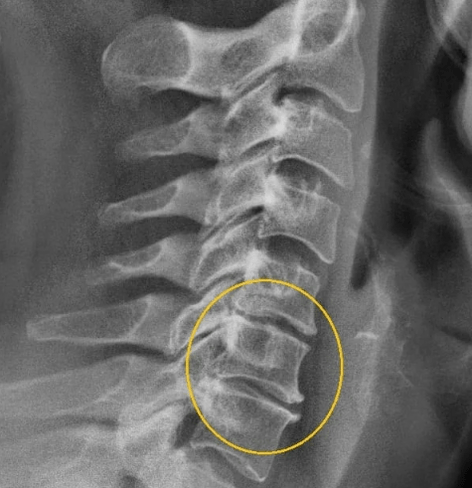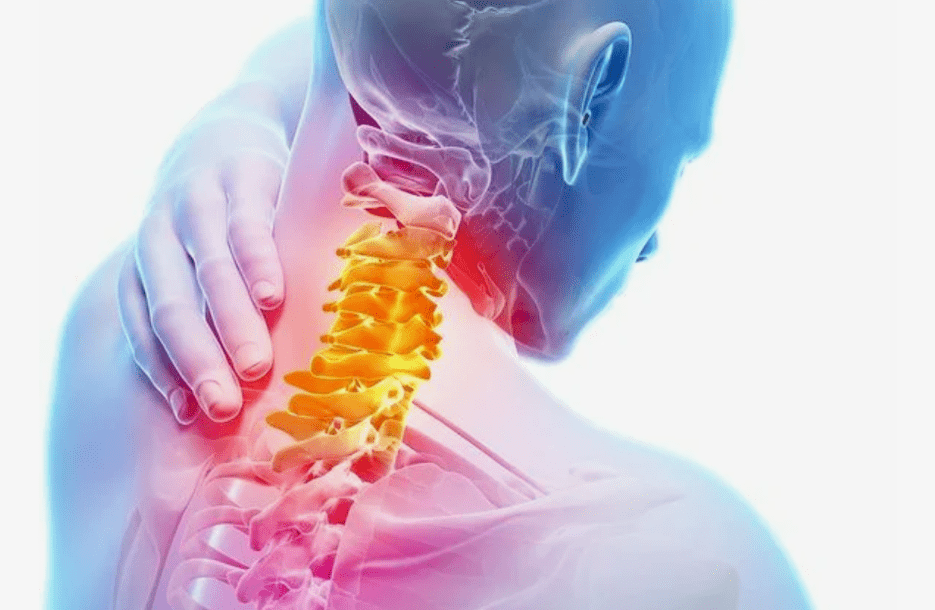Osteochondrosis is the usual spine pathology, characterized by a dystrophily change in the structure of cartilage discs of vertebrae and their bones. In one measure, osteochondrosis is manifested in most people after 30 years. The symptoms of cervical osteochondorosis are diverse, which often complicates the diagnosis and subsequent treatment.

General symptoms and signs of cervical osteochondrose
This process affects any spine or a few at once. Lumbar and cervical spine are most affected by pathology, as is more sensitive to the burden due to the anatomy of the human skeleton. The consequences of spinal osteochondrose in the cervical region cause the most gestures and potential complications, because the neck space is rich in neuromulus highways, many of which are not directly food.
For this reason, clinical symptoms with cervical osteochondrose are many associated with the ischemia of the brain. In addition, nervous roots that provide sensitivity and motor handling of hands and hand holder, when acquiring with destroyed vertebrates can give a variety of symptomatic images.
The signs of osteochondorosis for the neck depend on which of the body on systems is influenced by pathology:
- Interrupted blood circulation due to the compression of vertebral arteries determines most symptoms and marks from the brain.
- The root compression leaving vertebrates gives a picture of the peripheral nerve lesion.
- Having the spinal cord area is related to severe neurological pathologies found in advanced cases.
Below, consider the general clinic of osteochondrosis of the neck spine.
The pain in the back of the head, neck and collar
This is the most common symptom. The localization of pain can be expanded, influenced by shoulders, keyboards, breasts, crossing intensive head migraines. The nature of the pain depends on the localization of the lesion and the severity of pathology. Initially, pain can be quickly passable, gradually become chronic, painful. In times worsening pain becomes shooting, with increased tone of neck muscles and limited head movements.
Often pain with cervical osteochondrome can localize behind the sternum, in which case many patients take this symptom for angina pectoris. Differentiation can be performed by taking nitroglycerin tablets - pain due to osteochondrose, have not been removed.
Noise, ringing, earbudness sensation
These symptoms often join the hearing reduction. These phenomena are associated with the fall of blood flow from spine of spine to vestibular. The complex of these symptoms is called Kohlear or snails syndrome, and it is far from always possible to determine its connection with osteochondrose in the cervical region. The specific characteristic of differentiation is to feel noise, congestion and ringing in the ears when changing the position, after a long stay in one position.
Dizziness
It is also dizzy due to blood flow violation on the inner ear, which ensures the balance of the body. NYSTAGM often joins dizziness - arbitrary fluctuations in the eyes for the eyes on the sides.
Lack of air
This sensation occurs due to irritating the ends of the diaphragmatic nerve. It is a component of the throat nervous beam and is included in the regulation of breathing, depth and frequency. Patients complain about the impossibility of breathing full chest. In some cases, the symptom makes it difficult for serious shortness of breath and suffocation. For the same reason, breathing stops at night and crop. The lack of oxygen due to breathing problems is ultimately the cause of increased fatigue, reduction in a concentration and memory problem.

Nausea
He follows is belching air. Also due to blood circulation problems in some areas of the brain and inner ear. Nausea is sometimes noticed with rude vomiting, which is caused by head and body movements. The result of frequent nausea and vomiting is a reduction of appetite, loss of weight, food failure.
Vida problems
"Fly" in the eyes, falling sharpness of sight, fog in front of your eyes - these are all symptoms due to the ischemia of the area of the brain that is responsible for vision. Patients with osteochondrose complain less in the field of view, because the lack of blood supply from the roof vessels is compensated by blood flow from the carbon artery system. Glasses and therapeutic gymnastics for eye muscles do not solve the problem, usually a vision improves after osteochondrose treatment.
What are the most important symptoms of osteochondorosis in short in this video:
Board of blood pressure
An unstable pressure level is due to the weakened blood flow in the owulent brain, which is responsible for the functions of the vaccular motor center.
Sudden unconscesting or synchronic conditions
Spasm of the brain arteries is reported due to the short-term stopping of blood flow along vertebrates. From the state of losing the patient's awareness you can quickly remove by taking so that your legs are slightly larger than your head - blood flow to the brain allows the person to lead to life. After an unconsced attack, reversible speech and movement problems, due to the short stopping of blood flow, can be carefully noted for a while.
Greenous Symptoms
Often it may be the only sign that shows cervical osteochondrose. They are expressed as sweating, dryness and a feeling of lump in the throat, difficulty swallowing. The symptoms are associated with the compression of nervous plexus responsible for the innervation of Pharynx. It is necessary to distinguish such manifestations from a similar inflammation clinic or neoplasms.
Lifting body temperature
The growth of body temperature for cervical osteochondrose is not the lowest symptom, rarely and locally noted: in the area of cervix, with mild redness of the skin.
The stage of cervix can be, first, variable degrees of severity, it depends on the phase of pathology development, also in periods of deterioration, these are brighter, and other, to form in certain syndromes.

Symptoms depending on the cervical osteochondrose phase
Phase and
The beginning of degenerative processes in cartilage of vertebral discs. The symptoms are weak, sometimes it may not be noticed at all. The first signs of osteochondrose of the cervical spine:
- Discomfort in the neck, hands, shoulders, sometimes turn into pain;
- headache;
- easy to restrict the motor activity of the neck;
- quickly crossing vision impairment;
- Reducing the sensitivity of the skin of the collar environment.
IMPORTANT: These symptoms become more pronounced when leaning the head.
As a rule, in the first stage of osteochondrose of the cervical region, patients do not go to the doctor, believing that all symptoms are associated with fatigue, stress, age, age, lack of sleep.
Phase II
At this stage, the vertebrate protrusion begins, intervective cracks narrowing, the fiber fibrous ring of the collagen disk was destroyed. The symptoms of the point of nature are noticeably due to the compression of nerve troops, intensification during the movement of the door and turning the head. Here you can already suspect cervical osteochondrose, the symptoms in the second phase are as follows:
- Expressed neck pain, sometimes with a crisis;
- Shoulders and hand leather loses sensitivity almost entirely;
- The headaches are common, not passing long;
- Visual impairment with "flies" in the eyes;
- ringing and noise in ears;
- weakness of the upper extremity muscles;
- The clarity of the tendon reflex was reduced;
- Shoot pain with devotion under the shoulder;
- the feeling of lump in the throat, problems with swallowing;
- Sleep disorders, usually insomnia.
Long head keeping in one position leads to strong pain. At this stage of disease development, patients already come to a doctor for help.
Phase III
The owner of the ring in the disk is destroyed, make hernia. In the third phase there is a deformation of spine, displacement and dislocation of vertebrae because of their weak fixation. Symptoms are as follows:
- Intensive, acute neck pain, collar zone, heart space;
- the sensitivity of the scalp on the back of the head, in the rating, in the hands, to complete absence;
- Hernia of the neck of the spine;
- Parez and paralysis of the upper extremities;
- The tanular reflexes are practically not noticed.
This is a serious stage of the disease in which the patient can no longer support his head. The Ishemija of the spinal cord and the spine compression leads to a complete incapacity for moving and reducing the forces in the muscles in other parts of the body, as well as reduced spinal cords.

How to treat cervical osteochondrose
The described state of the spine is a very serious pathology that, with neglect, leads to disability, as well as the result of deep cerebral circulation disorders - and death. For this reason, self-interest in the case of such symptoms, you should not do. Osteochondrosis is treated in hospital and at home exclusively as a medical recipe. At the initial phases, the treatment of cervical osteochondrose is conservative, non-atheroid anti -infalmator medications, anesthetics, hormonal medicines, vitamin complexes - all this relieves inflammation, pain, improves the tissue trophy and cartilage.
In an acute period, medications are prescribed in the form of injections, because the pain overcomes, the patient goes into pills. Physiotherapy, massage, exercise exercises, usually prescribed in the remission phase, join the drug courses. In severe cases osteochondrosis is treated by surgery.






























